Davante Adams’ time with the Las Vegas Raiders appears to be coming to a close. The Raiders seem willing to accommodate the trade request Adams made last week. The reported asking for the three-time All-Pro wide receiver is a second pick and an additional asset.
Adams was originally scheduled to make $17.5 million in 2024. This $17.5 million was composed of a $16.89 million base salary, $510,000 in per game roster bonuses ($30,000 for every game active) and a $100,000 workout bonus that wasn’t earned due to a lack of participation in the offseason conditioning program. The hamstring injury Adams suffered that has kept him out of Las Vegas’ last two contests is also costing him $30,000 for each game he misses since he hasn’t been active on game day.
Adams, who will turn 32 years old on Dec. 24, is under contract for the next two years through 2026 for $72.5 million. It’s $36.25 million for both 2025 and 2026 consisting of a $35.64 million base salary, $510,000 in per game roster bonuses and a $100,000 workout bonus. None of the $72.5 million is guaranteed.
Trade compensation
The asking price for Adams is a little on the high side given the most recent trades of highly paid older wide receivers. The Los Angeles Chargers dealt Keenan Allen, who turned 32 during the latter part of April, to the Chicago Bears for a 2024 fourth-round pick in March. Allen is in the final year of a four-year contract extension averaging $20.025 million per year.
The Houston Texans obtained Stefon Diggs, who is 11 months younger than Adams, and a 2024 sixth-round pick from the Buffalo Bills for a 2025 second-round pick in early April. The remaining three years of the four-year extension Diggs signed in 2022 — averaging $24 million per year running through the 2027 season — were turned into dummy/voiding years. Diggs will be an unrestricted free agent next March because of this maneuver. The trade compensation the Bills received for Diggs is essentially a third-round pick.
The Raiders can point to the Atlanta Falcons’ trade of a 32-year-old Julio Jones in June of 2021 as justification for their asking price. The Tennessee Titans acquired Jones along with a 2023 sixth-round pick from the Falcons for a 2022 second-round pick and a 2023 fourth-round pick. Jones was under contract for three reasonably priced years (2021 through 2023) when the trade was made. Nonetheless, the Titans released Jones with a post-June 1 designation in March 2022 after an injury-plagued 2021 season.
Trade logistics
An obstacle to overcome in moving Adams besides trade compensation could be how trades work financially in the NFL. The acquiring team must have enough salary cap room to absorb the remainder of the player’s current salary in order to make a trade.
The amount of cap space necessary depends on the timing of the trade. To obtain Adams this week, the acquiring team needs $12,558,333 of cap room for the remaining 13/18ths of Adams’ base salary ($12,198,333) and 12 games worth of roster bonuses ($360,000) provided the bye hasn’t taken place.
The cap space needed decreases by $968,333 (938,333 or 1/18 th in base salary plus a $30,000 per game roster bonus) each week there isn’t a trade. At the trade deadline, which is Tuesday, Nov. 5 after Week 9’s games, it will cost $8.685 million to acquire Adams, assuming the team’s bye week hasn’t occurred. That’s nine weeks of base salary ($8.445 million) and eight games of roster bonuses ($240,000). Once the player is acquired, the new team can renegotiate or restructure his contract to decrease his cap number and/or salary.
Teams aren’t allowed to include cash or cap room in trades under NFL rules. The way around it is for the team and player to restructure the contract before the trade by converting salary into signing bonus. It operates essentially the same way as including cash or cap room because the acquiring team’s cap hit for the player in the current league year is reduced.
This type of maneuver is becoming increasingly common in trades at the deadline when an acquiring team has a tight salary cap. Eating salary in this manner has been a way to increase to the draft pick compensation received for a player.
That’s what the Denver Broncos did in 2021 when edge rusher Von Miller was dealt to the Los Angeles Rams at the trade deadline. Since the Rams weren’t in a position with the salary cap to absorb the Super Bowl 50 MVP’s remaining $9,722,222 2021 base salary, the Broncos converted $9 million into signing bonus prior to the trade. The Rams only had a $722,222 salary cap charge to acquire Miller, who was in a contract year. Denver got 2022 second- and third-round picks for Miller. The trade paid huge dividends for the Rams, as Miller gave the pass rush a shot in the arm en route to winning Super Bowl LVI.
This also occurred at last season’s trade deadline, which was the Tuesday after Week 8’s games, with defensive tackle Leonard Williams. The New York Giants did a $9,352,778 salary conversion before he was dealt to the Seattle Seahawks for a 2024 second-round pick and a 2025 fifth-round pick. This meant the Seahawks were only responsible for $647,222 of Williams’ remaining $10 million of base salary. The $647,222 represented 10 weeks worth of Williams’ $1.165 league minimum base salary. Williams was in a contract year, just like Miller.
There are two problems with this approach in Adams’ case. The Raiders aren’t inclined to do a salary conversion. Adams’ contract doesn’t contain the discretionary rights to convert salary into signing bonus that are in most NFL contracts. Even if the Raiders had a change about converting money, Adams’ cooperation would be required. Without his consent, the Raiders couldn’t send him to a cap-strapped team.
Adams presumably wouldn’t have a problem doing a salary conversion for the New Orleans Saints, who are one of his preferred trade destinations because of his history with quarterback Derek Carr. The Raiders were attractive to Adams because he was reuniting with his college quarterback at Fresno State. Adams wasn’t expecting Carr to be released after one season together in Las Vegas when he joined the Raiders in March 2022.
The Saints have $3.045 million of cap space, according to NFLPA data. Almost every contract imaginable has already been restructured for cap purposes. The only potential source of significant cap space would come from restructuring running back Alvin Kamara’s contract, as he has a $10.2 million 2024 base salary. A Kamara salary conversion this week would create just under $5.2 million of cap room. The nearly $8.245 million of cap space the Saints would have after a prompt restructure still wouldn’t be enough for Adams’ contract in a deal at the Nov. 5 trade deadline. Carr’s oblique injury in Monday night’s game against the Kansas City Chiefs, which could keep him out multiple weeks, is a new variable in the Saints’ equation.
A pre-trade base salary conversion is practically a necessity for a trade to the Saints. In a trade as early as this week, the maximum in base salary, like in the Miller’s and Williams’ examples, that could be converted is $11,324,444. This would leave the Saints responsible for just $1,233,889, which would consist of 873,889 in base salary (13 weeks of Adams’ $1.21 million league minimum salary) and $360,000 of the roster bonuses (12 games). At the trade deadline, this concept would require the Raiders to eat $7.84 million of Adams’ salary. The Saints would be picking up just $845,000 composed on $605,000 in base salary (nine weeks of minimum salary) and $240,000 or eight weeks of the roster bonuses.
It’s a different salary cap situation with Adams’ other preferred destination, the New York Jets. Adams was Jets quarterback Aaron Rodgers’ favorite target during most of their eight years together with the Green Bay Packers. It remains to be seen how the surprise firing of Jets head coach Robert Saleh after Week 5’s 23-17 loss to the Minnesota Vikings impacts a pursuit of Adams.
On the surface, the Jets have more than enough cap space to handle Adams’ contract with $15.68 million of room. Part of this cap space includes edge rusher Haason Reddick’s base salary being removed while he is holding out. Should Reddick end his holdout without any changes to contract, the prorated amount of his $14.25 million base salary would be restored to the Jets’ salary cap. With a return at the trade deadline, the Jets would be losing $7.125 million of cap room with Reddick back in the fold.
Defensive tackle Quinnen Williams would be the most logical source to create cap room given that his is $14.4 million base salary is the largest on the team. Because of this, the Raiders converting salary prior to the trade is less of a necessity.
A creative way to make a trade work without the Raiders eating salary or the acquiring team restructuring contracts would be to borrow a concept used when edge rusher Carlos Dunlap was dealt from the Cincinnati Bengals to the Seahawks as 2020’s trade deadline was approaching. Since Seattle didn’t have enough cap room to take on Dunlap’s remaining 2020 compensation, $3 million was taken from his base salary and moved into his 2021 contract year as a fifth-day-of-the-league-year roster bonus.
In Adams’ case, whatever amount of 2024 money he agrees to shift into a March 2025 roster bonus, whether that be the third or fifth day of the league year, would need be fully guaranteed because of his unrealistic 2025 and 2026 salaries. In order to keep the roster bonus from being prorated and treated like a signing bonus for salary cap purposes, the guarantees could kick in five days after the trade.
With Adams moving money into next year to get out of Las Vegas, any guaranteed March roster bonus in 2025 would need to have no offsets so he wouldn’t be in a worse position than leaving his contract alone. In the event he was released, he would get to double dip where he would earn the entire roster bonus and his salary with his new team instead of the acquiring team getting to recoup the guarantee from his next contract elsewhere.
Regardless of the trade logistics, the Raiders would have $15.7 million of dead money, which is a salary cap charge for a player no longer on a team’s roster, for Adams in 2025. The 2025 cap savings would be $28.4 million since Adams’ 2025 cap number is $44.1 million. His $44.1 million 2026 cap number would also be wiped off Las Vegas’ books in a trade.
Contract renegotiation
It’s hard to imagine that any team acquiring Adams would pay the $36.25 million in each of his 2025 and 2026 contract years. Those salaries were included for cosmetic purposes to artificially inflate his deal to $140 million over five years to make him the NFL’s highest-paid wide receiver on paper at $28 million per year rather than signing a three-year, $67.5 million per year contract averaging $22.5 million per year.
It wouldn’t be surprising for the acquiring team to explore renegotiating to a market value contract. A Super Bowl contending team, which the Jets and Saints are not, might be more comfortable with the prospect of Adams just being a half-season rental during which his future would be addressed in negotiations during the early part of the 2025 offseason.
Adams might view Tyreek Hill’s recently renegotiated contract with the Miami Dolphins as an important data point. Hill originally signed a four-year, $120 million extension in connection with his trade from the Chiefs shortly after Adams signed. In actuality, Hill had a three-year extension for $75 million because $45 million was in the final contract year. The 30-year-old Hill’s deal was reworked into $90 million over three years with $54 million guaranteed during training camp.
The acquiring team might be more comfortable with a deal in the Mike Evans neighborhood. Evans, who turned 31 in August, signed a contract to remain with the Tampa Bay Buccaneers that isn’t as good as originally advertised. His deal was originally reported as $52 million for two years averaging $26 million per year. That’s the maximum value of the contract if all $11 million of the incentives and salary escalators are earned, which is highly unlikely.
The base value is $41 million over two years to average $20.5 million per year. There are $35 million of guarantees where $29 million is fully guaranteed at signing. If Evans can continue to be the player he has been during the first 10 years of his NFL career, he should earn $6 million to $7 million of the performance bonuses to make $47 million to $48 million from the contract. Evans had essentially averaged 76 receptions for 1,168 yards with nine touchdowns per year heading into this season.
Final thoughts
Adams has likely played his last game for the Raiders, although there are several moving parts to trading him. Something is probably going to have to give for a trade to be made. The Raiders may have to be flexible on the trade compensation and soften their stance about eating salary to help consummate a deal. Adams may have to expand his horizons beyond his preferred destinations.
Don’t expect the Raiders to trade Adams within the AFC West to the Chiefs, the two-time defending Super Bowl champions. The Chiefs only have $4.26 million of cap space anyway, according to NFLPA data. The Raiders eating salary to help Kansas City’s three-peat efforts seems like a stretch.
The Bills abandoning their wide receiver-by-committee approach to give quarterback Josh Allen a primary receiving threat has similar challenges as a trade to the Saints. There’s only $2.881 million of cap room without any good options to create more through contract restructures.
The Pittsburgh Steelers could become serious suitors considering they made a strong push to acquire wide receiver Brandon Aiyuk from the San Francisco 49ers during the preseason. Having $8.078 million of cap space isn’t a problem. Edge rusher T.J. Watt and safety Minkah Fitzpatrick are viable contract restructure candidates because of respective $21.05 million and $14.5 million 2024 base salaries.
Read the full article here






















































